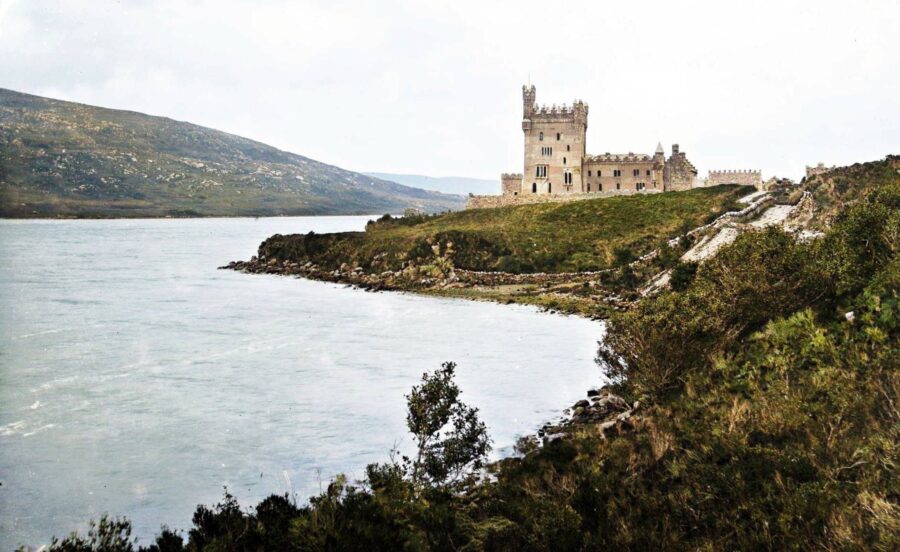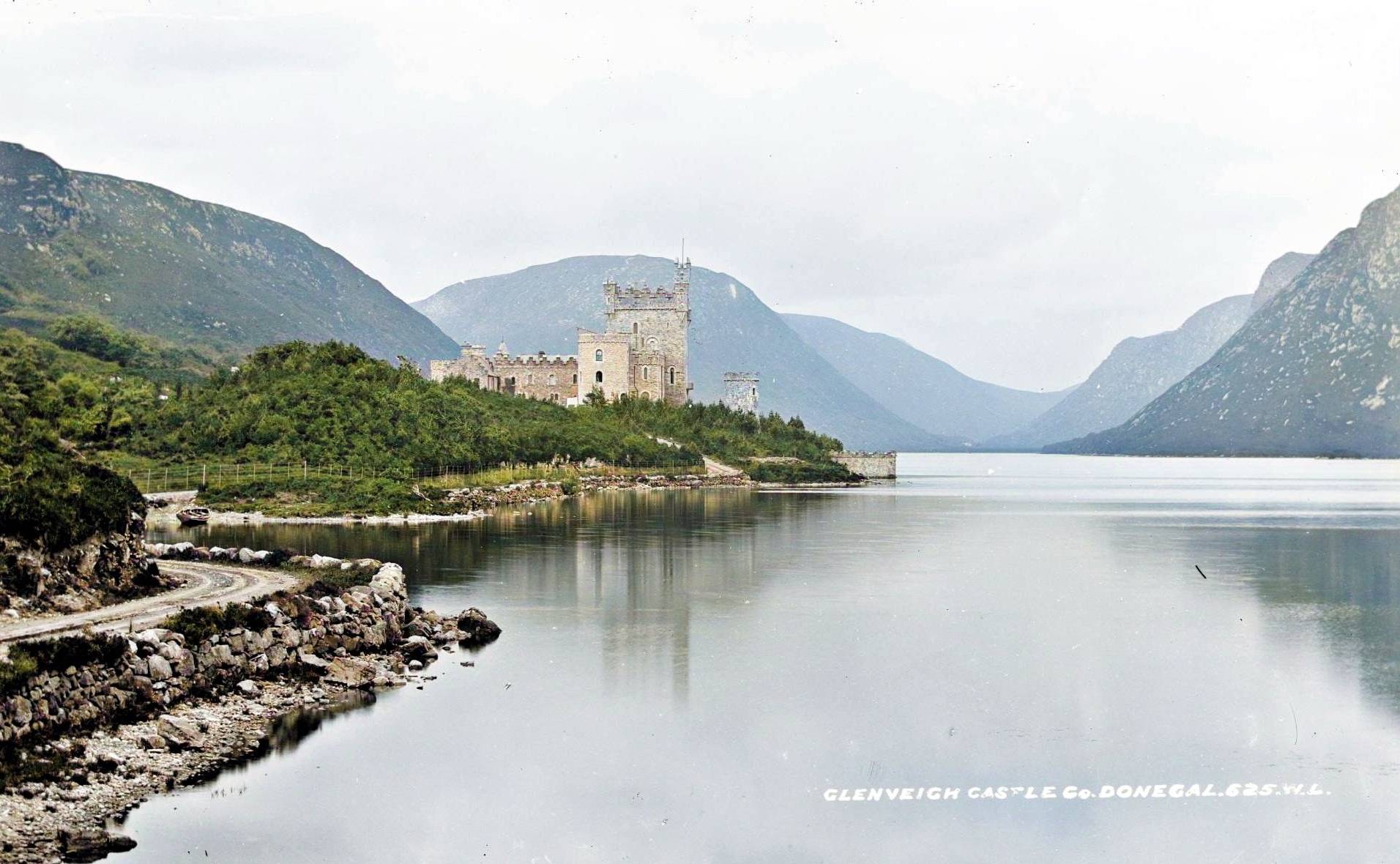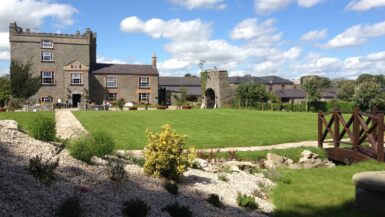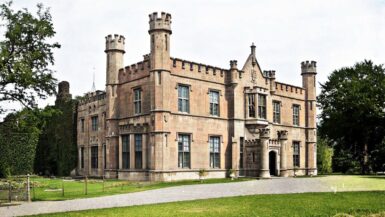Glenveagh Castle, a striking castellated mansion nestled in the heart of Glenveagh National Park in County Donegal, Ireland, stands as a monument of architectural grandeur and historical significance. Constructed in the late 19th century, this majestic estate captures the essence of Scottish baronial architecture, set against the rugged and picturesque landscape of the Irish countryside. The castle’s history is intertwined with the narratives of its various owners, each leaving their indelible mark on the estate, shaping its legacy through times of ambition, controversy, and cultural enrichment. Surrounded by a landscape that juxtaposes the wild beauty of Donegal with the cultivated elegance of its gardens, Glenveagh Castle embodies the cultural and natural heritage of Ireland. This article delves into the rich tapestry of Glenveagh Castle’s past, exploring the lives of its notable owners, the architectural evolution of the estate, and the transformation of its gardens into a horticultural masterpiece. As we journey through the castle’s history, we uncover the stories of ambition, artistry, and philanthropy that have culminated in the preservation of Glenveagh Castle as a cherished national treasure, open for the public to explore and appreciate.
Contents
The Construction of Glenveagh Castle
Glenveagh Castle’s origins date back to the latter half of the 19th century, a period marked by architectural innovation and the construction of grand residences across Ireland. The castle itself was built between 1867 and 1873, conceived and commissioned by Captain John George Adair, a figure whose wealth and ambition spurred the creation of this remarkable estate. Drawing inspiration from the Scottish baronial style, the castle was designed to echo the grandeur and majesty of similar structures found across the British Isles, particularly those reminiscent of Queen Victoria’s Scottish retreat, Balmoral.
The architectural style of Glenveagh Castle is characterized by its robust and dramatic features, including turrets, battlements, and a sense of imposing strength, blended with the romanticism of the era’s Gothic revival. The castle was constructed as a four-story rectangular keep, a design choice that not only projected power and prestige but also harmoniously integrated the structure into the surrounding landscape of mountains, lakes, and woods.
Captain John George Adair, born in County Laois and a member of the landed gentry, was the driving force behind the construction of Glenveagh Castle. Having amassed a fortune through land speculation in the United States, Adair returned to Ireland with a vision to establish an estate that would stand as a testament to his success and aesthetic sensibilities. His ambitions were grand; Adair envisioned creating an estate that would surpass the splendor of Balmoral, serving not only as a family residence but also as a symbol of his accomplishments and status.
Adair’s approach to the construction and development of Glenveagh Castle and its surrounding estate was methodical and driven by a clear vision. He sought to create a landscape that would complement the architectural beauty of the castle, involving the careful selection of the site, the design of the gardens, and the management of the vast tracts of land he had acquired. The choice of the Scottish baronial style for the castle’s design was a deliberate one, aimed at evoking the romanticism and grandeur associated with such estates, while also making a statement about the cultural and historical connections between Ireland and Scotland.
Understood, I’ll adjust the structure accordingly. Let’s dive back into the section on Captain John George Adair without the conclusion.
Captain John George Adair: Ambition and Controversy
Captain John George Adair, born into the landed gentry of County Laois in 1823, is a figure whose legacy is intertwined with both significant achievement and considerable controversy. His journey from Ireland to the United States and back was marked by a relentless pursuit of wealth, which he successfully achieved through astute land speculation across the Atlantic. This financial acumen enabled Adair to undertake the ambitious project of constructing Glenveagh Castle in County Donegal, an endeavor that aimed to reflect his status and aspirations.
Adair’s vision for Glenveagh was not limited to the architectural splendor of the castle itself but extended to the creation of an idyllic estate that would rival the grand estates of Europe. His efforts to beautify the Glenveagh landscape, however, were overshadowed by the Derryveagh Evictions in 1861. This decisive act of clearing the estate of its tenants to improve its aesthetic appeal and manage the land more effectively left an indelible mark on Adair’s reputation. The eviction of 224 tenants under his orders was viewed as particularly heartless, coming in the wake of the Great Famine, and it significantly tainted local and historical perceptions of Adair.
Despite the controversy, Adair’s impact on the aesthetic aspects of the estate is undeniable. He was deeply involved in the development of the castle’s surrounding gardens and the overall landscaping of the estate. His efforts to introduce exotic plant species and create landscaped vistas were aimed at enhancing the natural beauty of Glenveagh, demonstrating his commitment to realizing his vision for the estate.
The legacy of Captain John George Adair is thus a study in contrasts. While Glenveagh Castle and its gardens stand as a lasting testament to his ambitions and contributions to Ireland’s architectural and horticultural heritage, the memory of the Derryveagh Evictions serves as a somber reminder of the costs associated with his endeavors. Adair’s life and actions at Glenveagh encapsulate the complexities of 19th-century landownership and the delicate balance between personal ambition and the rights and well-being of the broader community.

Cornelia Adair: The Stewardship Continues
Following the death of Captain John George Adair in 1885, the stewardship of Glenveagh Castle and its expansive estate fell to his widow, Cornelia Adair. Unlike her husband, whose legacy was marred by controversy and harshness, Cornelia emerged as a popular figure within the local community and among the estate’s staff. Her tenure as the lady of Glenveagh is remembered for a distinct shift towards more benevolent management and a continuation of the estate’s enhancement, albeit with a more community-focused approach.
Cornelia, originally from the United States and having married John Adair in 1869, brought a different perspective to the management of the estate. She was deeply committed to improving the living conditions on the estate and fostering good relations with the local community, a stark contrast to her husband’s often tumultuous interactions with his tenants. Her efforts were not limited to social improvements; she also made significant contributions to the aesthetic and functional aspects of the castle and its grounds.
Under Cornelia’s guidance, Glenveagh saw further development of its gardens and the landscape. She continued the work initiated by her husband but with a greater emphasis on the integration of the gardens with the natural beauty of the Donegal landscape. Cornelia’s contributions went beyond mere aesthetics; she was instrumental in the implementation of advanced gardening techniques and the introduction of new plant species, enriching the biodiversity of Glenveagh’s gardens.
Her popularity was not solely due to her improvements to the estate but also stemmed from her character and her genuine care for the well-being of those living on and around the Glenveagh lands. Cornelia’s approachability and willingness to engage with the local community marked a significant departure from the previous era under her husband. This positive relationship with the local populace helped to heal some of the wounds left by the Derryveagh Evictions and began to reshape the estate’s image from one of exclusion to one of inclusion and beauty.
Cornelia Adair’s stewardship of Glenveagh Castle represents a pivotal chapter in the estate’s history, highlighting the positive impacts of empathetic and engaged management. Her efforts to enhance the estate’s beauty and her contributions to improving the lives of those associated with Glenveagh underscore her important role in the legacy of this historic estate. Through her work, Cornelia not only continued the development of Glenveagh’s gardens and grounds but also helped to foster a sense of community and goodwill that had been absent during her husband’s tenure.
Arthur Kingsley Porter: The Scholarly Owner
Arthur Kingsley Porter, a distinguished Harvard University professor with a profound interest in art and architecture, especially from the medieval period, became the owner of Glenveagh Castle in 1929. This acquisition marked a new chapter in the castle’s history, intertwining it with the life of an individual deeply engrossed in the study and appreciation of cultural heritage. Porter’s academic pursuits and personal interests in the development of Romanesque architecture and sculpture, as well as his passion for Irish archaeology and culture, brought a scholarly dimension to the stewardship of Glenveagh.
Upon acquiring Glenveagh Castle, Porter was keen to restore and preserve the architectural integrity of the estate. His appreciation for art and architecture influenced his approach to the restoration, ensuring that any modifications or additions were sympathetic to the original design and historical significance of the building. Moreover, his tenure saw the repair of the castle and the rebuilding of the deer fence, actions that underscored his commitment to both the preservation of the estate’s cultural assets and the protection of its natural environment.
Porter’s interest in the Celtic Revival and Irish mythology enriched the cultural tapestry of Glenveagh. His scholarly work, including the publication of “The Crosses and Culture of Ireland,” reflected his deep engagement with Irish heritage and contributed to the broader appreciation of Ireland’s cultural history. This intellectual backdrop added a layer of cultural depth to the estate under his ownership, marrying the physical beauty of Glenveagh with the rich tapestry of Irish art and mythology.
However, Arthur Kingsley Porter’s tenure as the owner of Glenveagh is perhaps most remembered for its mysterious conclusion. Porter disappeared in 1933 while staying on Inishbofin, a small island off the coast of Donegal. He had built himself a hermit’s hut on the island, seeking solitude and a closer connection to the landscape he had come to love. His disappearance left a shroud of mystery over Glenveagh. Theories about what happened to him abound, ranging from accidental drowning to deliberate disappearance, and even murder, each adding a layer of intrigue and speculation to the castle’s history.
Porter’s mysterious disappearance had a significant impact on Glenveagh Castle’s history, leaving the estate without its scholarly steward and opening the door to the next chapter in its ownership. The absence of a conclusive explanation for his fate has imbued Glenveagh with an air of mystery, enhancing its allure and inviting speculation and interest from visitors and historians alike. Arthur Kingsley Porter’s legacy at Glenveagh is a blend of scholarly enrichment and enigmatic departure, contributing to the castle’s rich tapestry of stories and its enduring appeal as a place of beauty, history, and mystery.
Henry McIlhenney: A Golden Era of Restoration and Society
Henry McIlhenney, an Irish-American hailing from a family of inventors and successful entrepreneurs, inherited not only a substantial fortune but also a keen artistic sensibility. His grandfather, John McIlhenney, had invented the first gas meter, and his father had served as president of the Philadelphia Museum of Art, deeply influencing Henry’s lifelong engagement with art and culture. In 1937, McIlhenney acquired Glenveagh Castle, marking the beginning of a period characterized by artistic flourishing and societal prominence within the walls of this historic estate.
Following the interruption of the Second World War, where McIlhenney served with distinction in the American Navy, he returned to Glenveagh in 1947 with renewed vigor to restore and enhance the castle. His artistic vision guided the restoration efforts, focusing on sourcing and placing artworks and furnishings that complemented the castle’s inherent beauty and historical significance. McIlhenney’s attention to detail and his appreciation for art and aesthetics breathed new life into Glenveagh, transforming it into a haven for art lovers and a testament to his refined taste.
The development of the castle’s gardens during McIlhenney’s stewardship was nothing short of revolutionary. Drawing on his artistic background and leveraging the unique climatic conditions of Donegal, he introduced a variety of exotic plants from around the world. The gardens were designed with an emphasis on aesthetics, featuring rhododendrons and other acid-loving plants that thrived in the local soil, alongside sweeping lawns and herbaceous borders that provided a tranquil and visually striking contrast to the rugged landscape. Under McIlhenney’s guidance, the gardens at Glenveagh became renowned for their beauty and diversity, attracting attention from horticulturalists and garden enthusiasts alike.
McIlhenney’s tenure at Glenveagh was also marked by the castle’s emergence as a hub of high society, hosting illustrious guests from around the world, including Hollywood icons like Greta Garbo and Grace Kelly. The lifestyle maintained at Glenveagh during this period was reminiscent of the grandeur of bygone eras, with lavish entertainment and a warm, welcoming atmosphere that endeared McIlhenney to his guests. The castle became synonymous with elegance and exclusivity, embodying the “Big House” lifestyle that had all but disappeared elsewhere in Ireland.
Ultimately, the demands of managing such a vast estate and the extensive travel required took their toll on McIlhenney. In 1975, he began negotiations to transfer Glenveagh Castle and its surrounding lands to the Irish state, culminating in the estate’s official handover in 1983. This decision ensured the preservation of Glenveagh’s natural and architectural heritage, allowing for the creation of a national park that would be accessible to the public. McIlhenney’s generous act of philanthropy marked the end of an era for Glenveagh but also secured its future as a cherished national treasure.
Henry McIlhenney’s legacy at Glenveagh Castle is defined by his artistic influence, the restoration of the castle and development of its gardens, and the vibrant social scene he cultivated. His decision to transfer the estate to the state underscored his deep appreciation for Ireland’s cultural and natural heritage, ensuring that Glenveagh would continue to enchant and inspire visitors for generations to come.
The Castle Gardens: A Harmony of Nature and Design
The gardens of Glenveagh Castle offer a stunning testament to the power of human creativity in harmony with nature’s raw beauty. Set against the backdrop of the rugged and wind-swept landscapes of Donegal, these gardens flourish in a setting that combines high rainfall and acidic soil conditions. Despite these environmental challenges, the gardens at Glenveagh are a showcase of botanical diversity and aesthetic brilliance, featuring exotic plants from the far reaches of South America, Tasmania, and China. The acid soil particularly favors the growth of rhododendrons, among which Glenveagh hosts an impressive collection, contributing to the gardens’ reputation as a horticultural haven.
Unique Setting and Climatic Challenges
Nestled at the foot of a steep wooded hillside and sloping down to the castle on the shores of Lough Veagh, the gardens at Glenveagh Castle thrive in an environment that would typically be considered hostile to such luxuriant plant life. The gardeners and caretakers have turned these seeming disadvantages—the high rainfall and acidic soil—into assets that support a wide variety of plant species. This adaptability reflects a deep understanding of the landscape and a commitment to cultivating beauty amidst the wildness.
Diversity of Plant Life and Aesthetic Arrangement
The gardens are meticulously arranged to showcase not just individual plants but also to create a visually stunning landscape that changes with the seasons. The variety of plant life is strategically placed to ensure year-round color and interest, with winding paths linking different sections of the garden, each with its own character and style. This careful planning ensures that the gardens are not just a collection of plants but a cohesive and immersive experience that draws visitors into a world where nature and design coalesce.
The Pleasure Grounds
At the heart of the gardens is the Pleasure Grounds, centered around a long, irregular lawn fringed by herbaceous borders and backed by a mix of trees and shrubs. This area functions similarly to a garden lake or pond, offering a tranquil, green space that contrasts with the surrounding ruggedness. The lawn serves as a restful visual anchor, around which the rest of the garden’s elements are arrayed, creating a sense of peace and harmony that is both pleasing to the eye and soothing to the spirit.
Transition to Public Ownership
In 1983, the stewardship of the gardens transitioned to the Office Of Public Works, marking a significant moment in the history of Glenveagh Castle’s gardens. This change in management ensured the continued care and development of the gardens, while also opening them up to the public in 1984. Visitors can now embark on a guided tour through the gardens, following a route favored by Henry McIlhenny, which includes 18 numbered stops. This public accessibility invites everyone to experience the beauty and tranquility of the gardens, allowing the legacy of Glenveagh’s horticultural excellence to be shared widely.
The gardens of Glenveagh Castle stand as a remarkable achievement in landscape design, overcoming environmental challenges to create a space of extraordinary beauty and diversity. The transition to public ownership under the Office Of Public Works has not only preserved this unique horticultural heritage but has also allowed it to flourish, offering visitors from around the world the opportunity to experience the magic of Glenveagh’s gardens.
State Ownership and Public Access
The transition of Glenveagh Castle and its surrounding estate into state ownership marks a pivotal chapter in the property’s storied history. This significant shift occurred in the mid-20th century, culminating in the establishment of Glenveagh National Park, a momentous event that underscored the importance of preserving Ireland’s natural and cultural heritage for future generations. The decision by Henry McIlhenney to transfer the estate to the Irish state was driven by a vision that recognized the unique value of Glenveagh, not only as a private haven but as a national treasure that should be protected and shared with the public.
The Establishment of Glenveagh National Park
In 1975, the process began with McIlhenney’s agreement to sell the estate to the Office of Public Works, leading to the formal creation of Glenveagh National Park. Officially opened to the public in 1984, the park spans thousands of acres, encompassing the castle, gardens, and a vast expanse of rugged Donegal landscape. This designation as a national park highlighted the area’s ecological significance, including its diverse flora and fauna, and its cultural importance, embodied by the historic castle and its gardens. Glenveagh National Park stands as a testament to Ireland’s commitment to conservation and public enjoyment of its natural landscapes and historical sites.
Impact of Public Access
The opening of Glenveagh National Park to the public has had profound implications for the preservation and appreciation of the estate. Public access to the park and castle has democratized the enjoyment of this once-private estate, allowing visitors from Ireland and around the world to experience the beauty and tranquility of Glenveagh. The ability to explore the castle, stroll through the exquisite gardens, and hike the surrounding landscapes has made Glenveagh a beloved destination for nature enthusiasts, history buffs, and those simply seeking refuge in its serene environs.
Moreover, state ownership has ensured that the necessary resources are allocated towards the maintenance and preservation of the estate. This includes the careful management of natural resources, the protection of wildlife, and the restoration and conservation of the castle and its gardens. Public access has also raised awareness about the importance of preserving Ireland’s cultural and natural heritage, fostering a sense of collective responsibility among visitors to respect and protect this precious asset.
The transition of Glenveagh Castle and its estate into state ownership and the subsequent establishment of Glenveagh National Park represent a successful model of conservation and public engagement. By granting access to this magnificent estate, the state has not only preserved a piece of Ireland’s heritage but has also enriched the cultural and recreational life of the nation. The impact of public access on Glenveagh has been overwhelmingly positive, ensuring its preservation for future generations while allowing the public to enjoy and appreciate the unique beauty and history of the estate.
Conclusion
Glenveagh Castle, with its dramatic setting amidst the wild beauty of County Donegal, Ireland, stands as a monument to both the ambition of its creators and the enduring value of natural and cultural preservation. From its construction in the late 19th century by Captain John George Adair to its role as a hub of high society under Henry McIlhenney, the castle has been a focal point of both controversy and celebration. Its history reflects a tapestry of human endeavor, from the contentious legacy of Adair and the Derryveagh Evictions to the artistic and scholarly contributions of Arthur Kingsley Porter, and finally, to the philanthropic vision of McIlhenney, who ultimately ensured the estate’s transition into public ownership.
The establishment of Glenveagh National Park and the opening of the castle and its gardens to the public have transformed Glenveagh from a private estate into a national treasure. This transition underscores the castle’s historical and cultural importance, preserving its legacy while making its beauty and history accessible to all. The state’s stewardship of the estate ensures that the natural environment, as well as the architectural and horticultural achievements embodied in the castle and its grounds, are protected for future generations to explore and enjoy.
Reflecting on Glenveagh Castle’s evolution highlights the broader theme of conservation and the role that individual and collective efforts play in safeguarding cultural heritage. The story of Glenveagh is a testament to the importance of preserving such places of beauty and historical significance, not just as monuments to the past but as living spaces that continue to inspire and educate. As Glenveagh Castle continues to welcome visitors from around the globe, it stands as a symbol of Ireland’s commitment to its history, culture, and natural landscape, offering a window into the past and a space for reflection and connection with the natural world.
In conclusion, Glenveagh Castle’s journey from a symbol of individual ambition to a cherished public asset encapsulates the transformative power of preservation and public access. It serves as a reminder of the complex narratives that historic estates can hold and the positive outcomes that can arise from embracing a future where such treasures are shared and celebrated. Glenveagh’s enduring appeal and significance lie in its ability to bridge the past and present, inviting all who visit to partake in its storied and scenic splendor.






Leave a reply